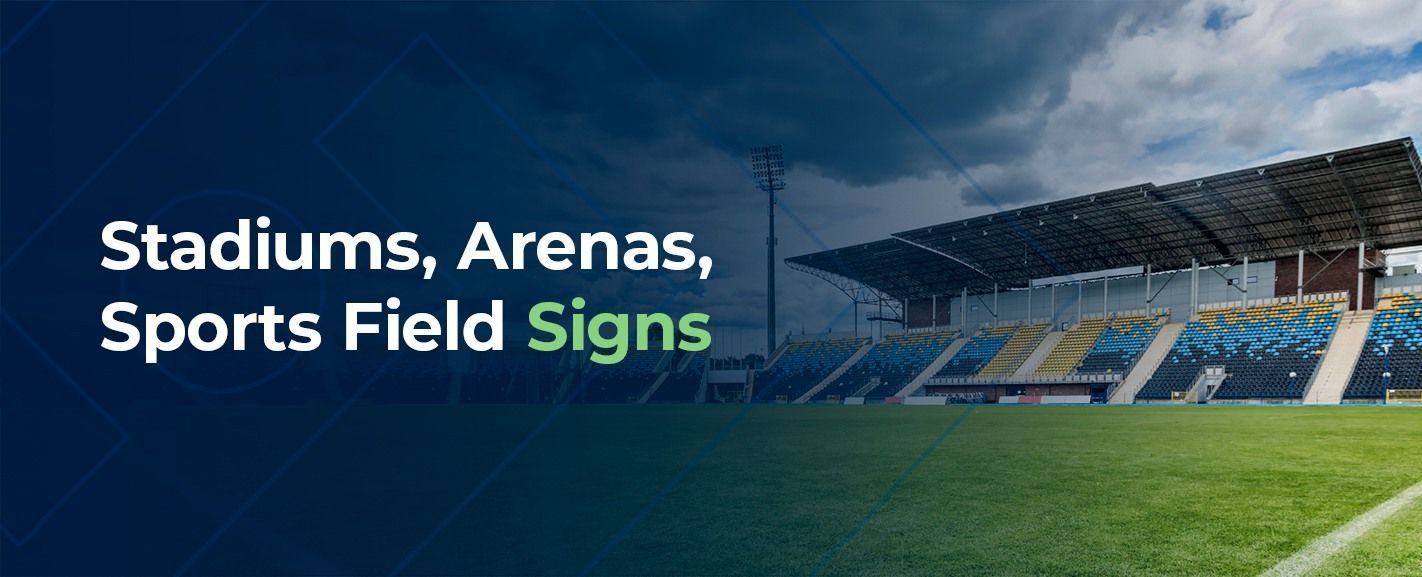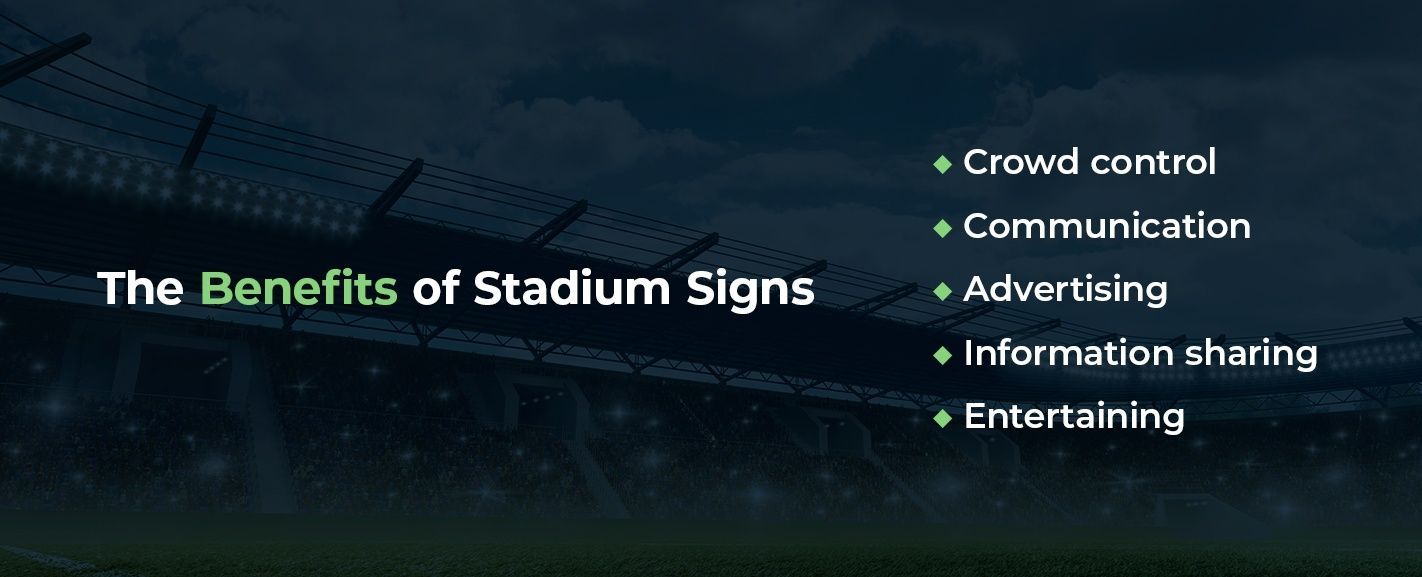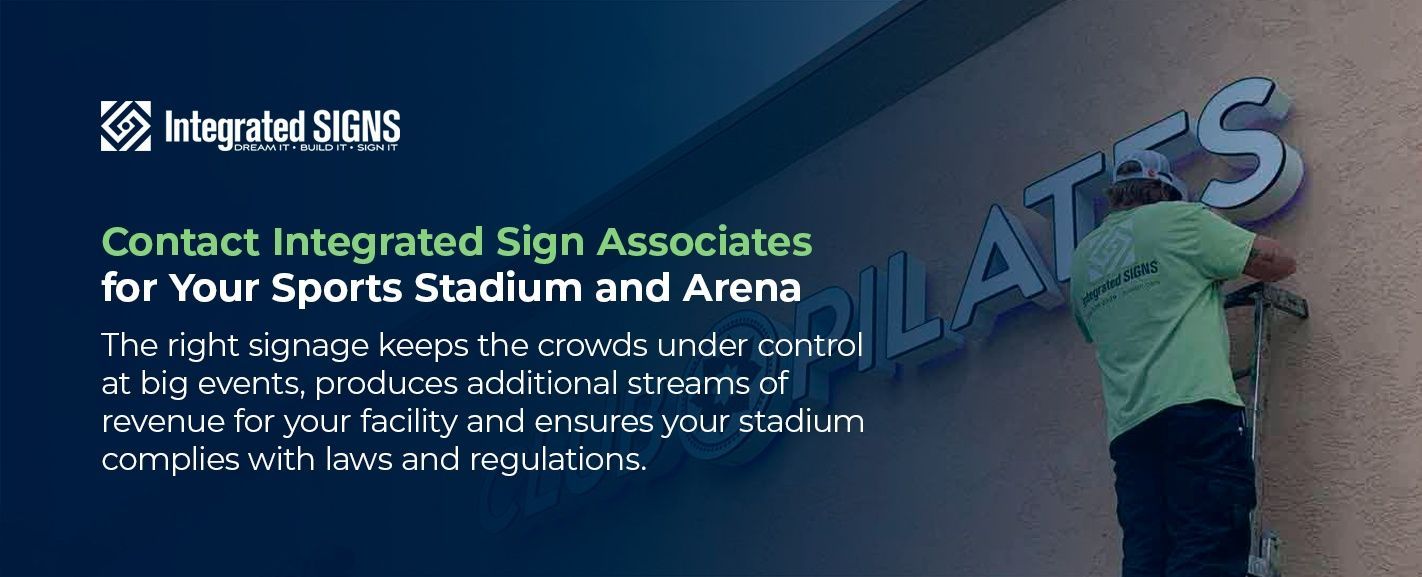It’s the day of the big game, and players are starting to arrive. Soon, spectators will get to the stadium to take their seats and watch the action unfold. What guides players, spectators and everyone else involved in the process of producing a sporting event or another type of live entertainment to where they need to go? Signage. Sports stadium signage ranges from massive pylons at the entrance to the parking areas and small row markers that guide ticket-holders to the correct seat. Without the right signs or an adequate number of them, stadium-sized events would be challenging to pull off.
Whether you are rebranding your stadium after a name change, updating existing signage or setting up a sports arena for the first time, getting the signage right is critical. Consider this your guide to all the signs you’ll need at your stadium and the sports field.
The Benefits of Stadium Signs
There are lots of reasons to install signage at a sports arena. Perhaps the most critical reason is that the signage acts as an identifier. It labels the stadium and lets people know they are in the right place. At particularly large sports complexes that have multiple parking lots, signs let people identify where they have parked their car, making it easier to return to it at the end of the event.
Other benefits of sports stadium signage include:
- Crowd control: The biggest stadiums can easily accommodate a crowd size in the tens of thousands. That’s a lot of people sharing the same space. Signage helps to keep that crowd under control. It can clearly state the rules of the stadium, such as “no smoking,” or it can tell people the correct direction to travel in as they move up and down aisles or in and out of the building. In the event of an emergency, appropriate signage can help the evacuation process go as smoothly as possible.
- Communication: Stadium graphics also allow for easy communication. A sign can identify the section of the stadium, list the rules or tell a visitor what products are available to purchase. Digital signage in a stadium can communicate immediate messages, such as changes in the line-up for the game or a new start time.
- Advertising: Signs can open up an additional stream of revenue for a sports arena. For example, the stadium can sell advertising space in the form of banners hung around the perimeter of the playing field. If a digital display is available, you can sell advertising space on it as well.
- Information sharing: Signs share information with the people who see them. That information can be fundamental, such as “this is the restroom” or “this is the elevator.” Or it can be more in-depth, such as a sign at the entrance to the stadium that includes a story detailing its history.
- Entertaining: Signs can also keep people entertained while they wait for an event to begin. The Kiss Cam is a common example. During an event, a camera roves the audience, looking for couples. They then appear on a large digital screen in the middle of the arena, and the rest of the audience can watch them kiss.
Common Types of Stadium and Arena Signs
To effectively communicate with visitors, guide people through a stadium and convey information, all while creating a fun and welcoming environment, you’re going to need a wide variety of signs. Some examples of the types of signage to install inside or outside a stadium or arena include the following.
Interior Signs
Interior signs can include everything from the logos that greet visitors as they step into the lobby of an arena to the plaques on restroom doors. Interior signs can also be creative and engaging, such as environmental graphics. Environmental graphics might cover an entire wall of a hallway in a stadium and can tell a story about the stadium’s history or about the teams that play there. An example might be a timeline that shares fun and interesting facts about the building or about the team. Visitors can look at the timeline as they walk through the hall to their seats or concession stands.
Field Signs
Field signs can take several forms. They can be advertising banners that hang around the perimeter of the field, displaying the brand name and logo of a team’s sponsor. They could also be a sign that provides the name of the stadium itself or the names of the teams that are playing.
Wayfinding Signs
If you’ve ever gotten lost at a stadium or arena, then you can see the value of wayfinding signs. Wayfinding signs provide people with directions or instructions. They can be your basic arrow signs, or they can be a lot more exciting and engaging. Digital directories that light up and guide a person from point A to point B provide a modern spin on wayfinding.
Directory signs don’t have to be digital to get the job done, though. Color-coding the signs and having the colors match certain sections of the stadium can make it easy for people to make their way to their seats, the restroom or the nearest snack stand.
Outdoor Stadium Signage
Outdoor stadium signage comes in a variety of shapes and sizes. It can be the larger-than-life lettering on the side of a stadium that people can see as they drive by on the street. It can be a monument sign near the entrance that guides people to the door and lets them know they’re in the right spot. It can also be a towering pylon sign near the parking lot that identifies the stadium and the lot letter or number.
LED Sports Arena Signage
LED signs let you change up the messaging on the sign easily, which can be particularly useful if your stadium hosts a variety of events, such as sporting events, concerts and conventions. You also have a lot of options when it comes to what you display on the signs. If you have digital LED signs around the perimeter of the seating area of the stadium, you can have them share fun facts about the team players or about the band that’s performing at the arena. On the exterior of the stadium, an LED sign can list upcoming events and the dates of those events.
Other Examples of Sports Complex Signs
A few more examples of the types of signs you might use at a stadium include:
- Menu boards: Menu boards let hungry visitors know what snacks are available to purchase and how much those snacks will cost.Digital LED signage lets you easily update the menu as options change.
- Regulatory signage: Regulatory signs let people know the rules of the stadium, such as “no smoking.” They also restrict access to certain areas, such as the locker room or press box.
- ADA signage: To comply with ADA guidelines, certain signs need to include specific details, such as Braille lettering and raised characters. The signs need to be placed at an appropriate height so that people who use wheelchairs can reach them.
Why Work With Integrated Sign Associates
If you’re working on updating your stadium branding and need new signs, turn to Integrated Sign Associates for help. We take a “customer comes first” approach with all of our projects, and we are committed to providing you with an excellent experience and with quality signs that stand the test of time.
We have a top-down management structure and will be with you every step of the way, from the design of your signs through the installation. We’re dedicated to providing only the best to our customers, which means we don’t cut corners or deliver less than what we promised.
Contact Integrated Sign Associates for Your Sports Stadium and Arena Signage Needs
The right signage keeps the crowds under control at big events, produces additional streams of revenue for your facility and ensures your stadium complies with laws and regulations. To get started, contact us today for an estimate.



